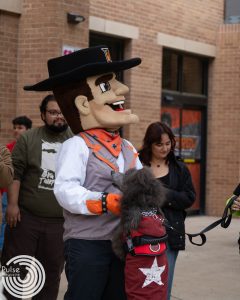Bringing Back the Tamaulipan Thornscrub Forest
The Quad: connecting students to nature, the ecosystem and history.
Photos by Veronica Palacios
Juan Ortiz is a campus architect and Leader in Energy and Environmental Design (LEED) accredited professional. Four acres is all he had to work with for the drainage project that led to the redesign of the Edinburg campus quad.
The goal was to redirect the water that floods the campus during every major storm event and to beautify the space while they were at it. With the help of Ten Eyck Landscape Architects in Austin, they were able to transform the area into what it is today.
After the recent rainfall, we see thriving green and blooming flowers in all corners of the Quad. What you may not know is that the plant life that can be seen on the Edinburg campus is the same that our grandparents saw in the Rio Grande Valley before the major areas were developed to have car washes and coffee shops on every block. Mexican Buttonbushes, Sabal minors and Birds of Paradise surround the Quad, giving one the feeling that they could have gone back in time one hundred years.
Juan Ortiz works to make the campus beautiful, usable and sustainable but he has a personal connection to the Edinburg campus as well.
“I grew up three blocks from campus and that was my playground,” Ortiz said. “I would ride bikes around campus and everything else. So, I have a personal attachment to the campus itself.”
This history made all the difference in the decision making process. Ortiz knew that what they did with the Quad would be utilized and appreciated for generations to come.
After seeing a presentation that Christine Ten Eyck did at Quinta Mazatlan, Ortiz knew that he wanted the company of landscape architects to “do [their] magic” for the Quad drainage project.
Christine Ten Eyck started Ten Eyck Landscape Architects in 1997. The company’s objective in this case was to connect students with their native ecosystem and to mitigate the flooding in the area. This was done by choosing plants native to the valley and creating swales and basins that provide “bathtubs for plants and water.”
“It’s sculpting the earth to hold water versus to run it off and then planting the plants that slurp it up,” Ten Eyck said.
Ortiz explained that the native plants absorb water better and are deep rooted, they hold onto dirt. That way when major storm events occur the drains don’t get clogged and decrease its effectiveness.
“So, the whole quad development with the plants and with the drainage, the way it’s set up is designed to do a couple of things; manage where it goes and then the vegetation slows the erosion,” Ortiz said.
Ortiz emphasized that the plants that are native to the region are tougher and more effective choices because they are suited to the area and able to withstand rough conditions.
“So, that’s why we choose the plants that we choose,” Ortiz said. “The plants we choose hold onto the dirt better. They require less water so they’ll last longer. What happens is, say, like, this year got really hot, right? We were in drought conditions. You will see it around the neighborhoods. A lot of people’s lawns basically dried up. They couldn’t keep up. Everything turns brown. All that grass dies. There’s no more vegetation to hold the dirt where it’s supposed to go.”
Ten Eyck Landscape Architects are experts on the subject. Associate Alex Morvant, who worked on the UTRGV Quad project, says that their objective is a simple one.
“Function can also be beautiful,” Morvant said. “It doesn’t have to be ugly.”
Ten Eyck said that with urban development comes the destruction of plant life and the ecosystem. Her goal is to show the beauty that can be found in the nature that was here originally, but is being covered with cement for development.
“They estimate that only five percent of the existing native landscape still remains in South Texas,” Ten Eyck said. “Five percent. So, with every project we’re doing, we are trying to imbibe that fabulous landscape back into each project.”
Morvant added that bringing back nature is restoring the connection to the environment and to our culture.
“It connects people to the culture of the area because the ecology that you’re in is sort of part of the culture,” Morvant said. “So, it’s a piece of history that we lose in connection to the landscape and to nature. Bring back those native plants to build that.”
“We’re just carrying on the flame of the love of our native plants,” Ten Eyck said. “It’s owning your own geography and not trying to make it look like an Ivy League school. We don’t need those Ivy League schools. We got ourselves Texas schools and to heck with trying to imitate being in England. It’s about really trying to have the character and hopefully getting people to feel pride in their native character instead of always wanting to look like someone else.”
Edna Zambrano says that the plant life that is unique to our area should be appreciated as it connects us to our past and our future.
Zambrano is the Student Unions and Conference Services Director and has worked for The University of Texas Rio Grande Valley for 20 years. She was chosen for the team of student leaders and university employees that provided feedback on the project. She had a bird’s-eye view of the evolution of the project from the second floor of the Student Union and an inside look into the process while on the team.
“I think [the plant life] is part of the history of the valley and for the students to understand where they come from, where they live,” Zambrano said. “I think it also gives you an understanding of what this land looked like years ago, you know, centuries ago. Like, what did this area look like when it was inhabited by Native Americans or native people? They lived off this land. …
“The plant life, the sounds of the birds and bees, butterflies in view, has become a way for students to connect to nature and themselves on a deeper level. It’s been here for hundreds and hundreds of years and we’re just working to preserve it. Maybe we put a little path so we can walk through it safely. But this is what it looked like. This is what our ancestors walked on and saw years and years and years ago.”
Native plants require up to 80% less water than non-native plants. Landscapes that are beautiful and also sustainable are what Ten Eyck and her company are after. Ten Eyck says that it could catch on. The restoration of the Valley’s Tamaulipan Thornscrub Forest could happen in your own backyard.
[smartslider3 slider=”11″]




